Nuido, the art of Japanese Embroidery, represents a centuries-old tradition deeply embedded in the cultural tapestry of Japan.
Derived from the fusion of “Nui” (sewing or embroidery) and “Do” (way or path), Nuido signifies the meticulous journey of needlework.
Originating for practical use on garments and religious items, this craft has transcended utility to become a revered artistic pursuit.
Characterized by precision, intricate motifs inspired by nature, and symbolic meanings, Nuido practitioners, or Nuidoshi, undergo disciplined training. Beyond being a craft, Nuido serves as a meditative practice, fostering mindfulness and patience.
Its contemporary expression seamlessly blends tradition with innovation, captivating enthusiasts worldwide with its timeless beauty and cultural significance.
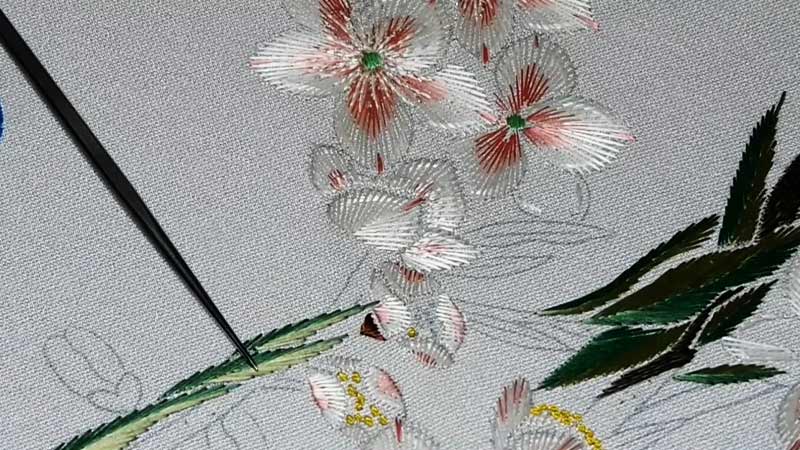
Brief History of Japanese Embroidery
Japanese Embroidery, or Nuido, has a rich history rooted in ancient Japan. Originating for practical purposes, it adorned garments, textiles, and religious items.
Over centuries, it evolved into an esteemed art form characterized by precision and symbolism. Nature-inspired motifs like flowers and animals dominate designs, reflecting cultural and spiritual themes.
The disciplined training of Nuidoshi (embroidery artists) covers various stitches, fabrics, and historical contexts. Nuido gained recognition as a contemporary art form, blending tradition with innovation.
Today, practiced globally, it serves as a meditative craft, fostering mindfulness and patience and preserving a timeless and beautiful Japanese tradition.
What Is Nuido Japanese Embroidery?

Nuido, or Japanese Embroidery, is an intricate needlework craft with deep cultural roots in Japan. The term itself combines “Nui,” meaning sewing or embroidery, and “Do,” representing the path or way of this art.
Dating back centuries, Nuido has evolved from practical applications on garments and religious items into a highly esteemed artistic tradition.
The craft emphasizes precision, attention to detail, and the use of high-quality materials. Nature-inspired motifs like flowers and animals are prevalent, each carrying symbolic meanings.
Practitioners, known as Nuidoshi, undergo systematic training, progressing from basic stitches to complex techniques.
Nuido is both an art form and a meditative practice, encouraging mindfulness and patience.
In the contemporary context, Nuido blends tradition with innovation, with artists worldwide contributing to its preservation and evolution.
This timeless and beautiful craft continues to captivate individuals, connecting them to Japan’s rich cultural heritage.
Free Japanese Embroidery Patterns
Japanese embroidery, known as “nihon shishu” or “nihon shishu no minamoto,” has a rich history dating back over a thousand years.
It is a traditional craft that has evolved into a sophisticated art form, characterized by meticulous attention to detail and a harmonious blend of colors and textures.
Embroidery in Japan has been used to embellish various items, including clothing, accessories, and household items.
Here are the most popular free Japanese embroidery designs:
Kamon (Family Crests)
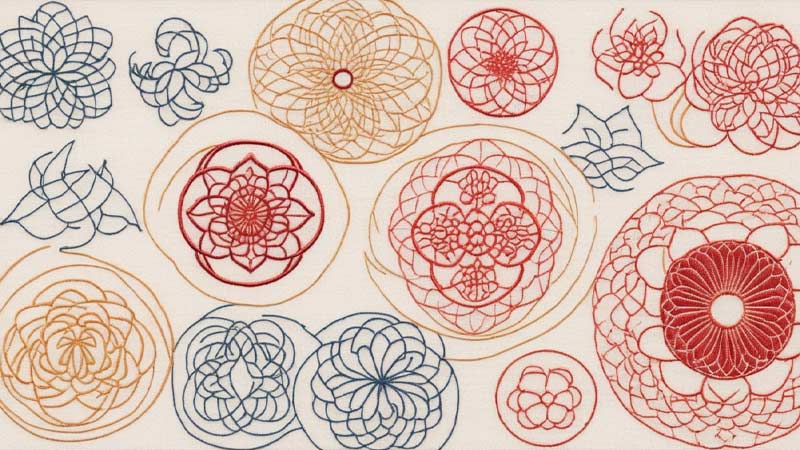
Kamon, or family crests, have a rich history in Japan, dating back to the Heian period (794-1185). These symbols were initially used to identify and represent noble families on battle flags and garments.
Today, they are cherished emblems that convey a sense of heritage and identity. Kamon designs often feature stylized depictions of nature, such as flowers, animals, or geometric shapes.
Incorporating kamon into embroidery projects allows for a personalized touch, making it a unique and meaningful expression of cultural heritage.
The precise stitching required for these intricate designs emphasizes the artistry and craftsmanship inherent in Japanese embroidery.
Sakura (Cherry Blossoms)
Cherry blossoms, or “sakura,” hold a special place in the hearts of the Japanese people. Beyond their aesthetic beauty, sakura symbolizes the transient nature of life and the renewal that comes with spring.
In Japanese embroidery, sakura motifs can be adapted into various patterns, ranging from delicate single blossoms to entire branches.
The artistry lies in capturing the fragility and grace of these blooms through careful stitching and a harmonious blend of colors.
Embroidering sakura allows crafters to evoke the essence of Japanese seasons and express the profound cultural significance attached to these fleeting flowers.
Koi Fish
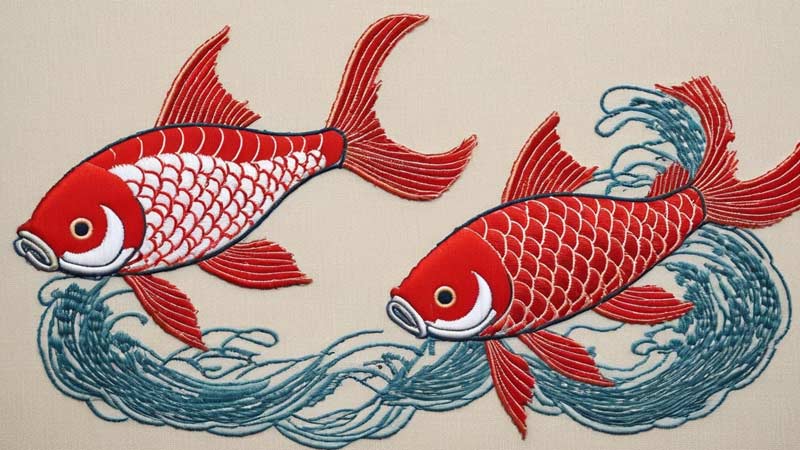
Koi fish embody strength, perseverance, and good fortune in Japanese culture. These fish’s vibrant colors and flowing movements make them popular subjects for intricate embroidery patterns.
Crafting a koi fish in embroidery involves meticulous attention to detail, particularly in capturing the fish’s scales and dynamic, flowing lines.
Incorporating koi into embroidery projects not only celebrates their symbolic meaning but also showcases the skill of the embroiderer in bringing these powerful symbols to life.
Ume (Plum Blossoms)
Ume, or plum blossoms, share a similar cultural significance with cherry blossoms but are distinguished by their association with winter and early spring. Ume motifs in Japanese embroidery capture the elegance and timelessness of these blossoms.
The stitching may emphasize the delicate petals and the contrast between the subtle colors, creating a design reflecting the quiet beauty and resilience of plum blossoms during the colder months.
Cranes
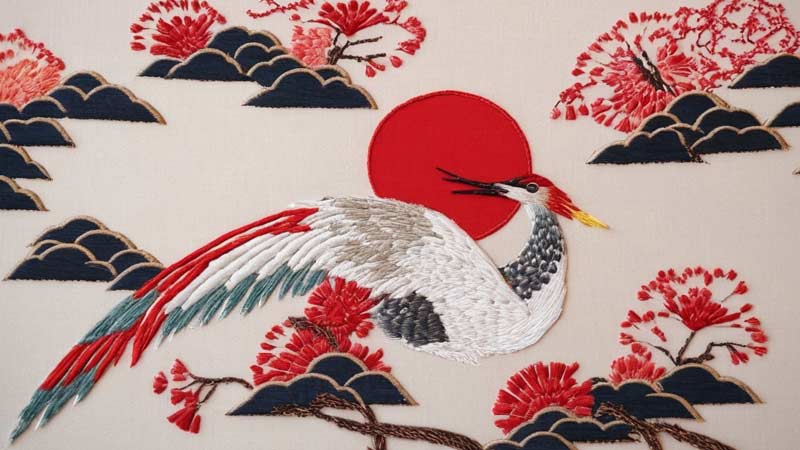
Cranes are revered in Japanese culture as symbols of longevity and good luck. Embroidering cranes involves intricate stitching to capture the grace and detail of these majestic birds.
The use of various embroidery techniques, such as satin stitching and French knots, can bring out the texture of feathers and the elegance of the crane’s form.
Incorporating cranes into embroidery projects adds a touch of symbolism and showcases the artist’s skill in portraying intricate and meaningful motifs.
Traditional Japanese Patterns
Exploring traditional Japanese textile patterns opens up a world of geometric designs, each with its own historical and cultural significance.
Seigaiha (waves), asanoha (hemp leaves), and karakusa (arabesque) are timeless motifs that have been used for centuries. Adapting these patterns to embroidery projects adds a touch of authenticity and cultural richness.
The precision required in stitching these intricate patterns highlights the craftsmanship involved in Japanese embroidery, providing a link to the country’s artistic traditions.
Different Types of Japanese Embroidery
Japanese embroidery encompasses a variety of techniques and styles that have evolved over centuries. Each type of Japanese embroidery reflects a distinct tradition, purpose, and artistic expression.
Here are some of the different types of Japanese embroidery:
1. Nuido (Japanese Embroidery)
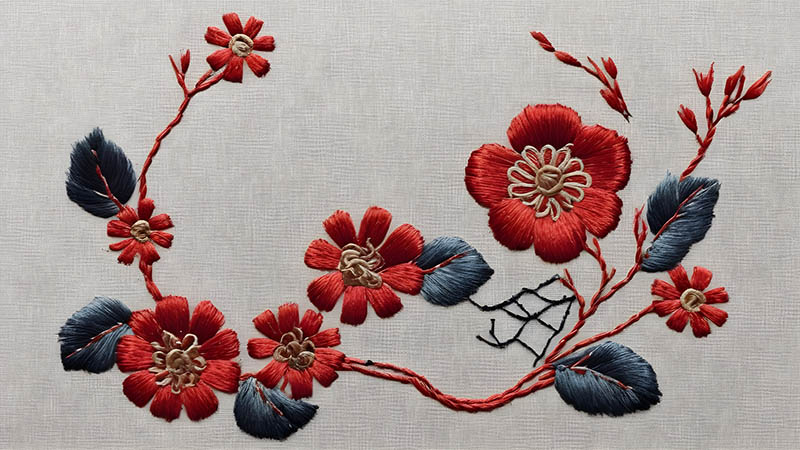
- Overview: Nuido, meaning “Japanese embroidery” in Japanese, is the general term that encompasses various styles and techniques. It refers to the broader practice of embroidery in Japan.
- Characteristics: Nuido includes a wide range of embroidery styles, from traditional to contemporary. It incorporates various stitches and materials, allowing for creative expression and adaptation to different projects.
2. Nihon Shishu (Japanese Traditional Embroidery)
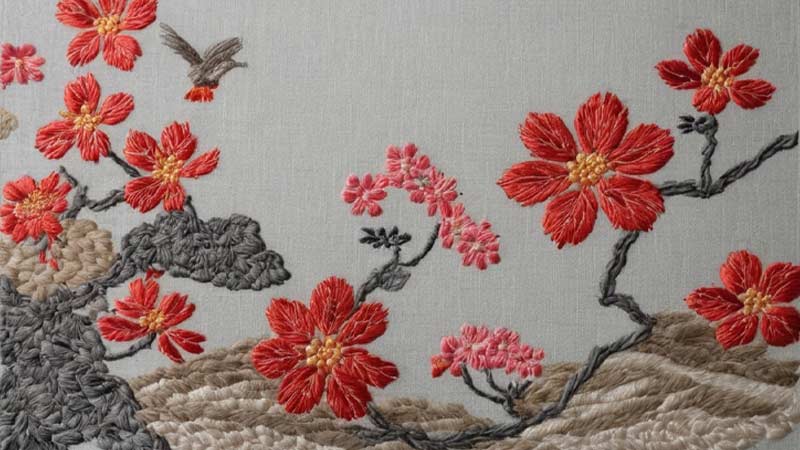
- Overview: Nihon Shishu, often translated as “Japanese traditional embroidery,” is a highly refined and intricate embroidery with deep cultural roots.
- Characteristics: Nihon Shishu emphasizes precision and attention to detail. It often uses silk threads and gold and silver metallic threads and incorporates symbolic motifs such as flowers, animals, and landscapes. The stitches are carefully chosen to achieve a harmonious and elegant result.
Sashiko Embroidery
- Overview: Sashiko is a traditional Japanese embroidery technique primarily used for decorative stitching on fabric, particularly in quilting and reinforcing fabrics.
- Characteristics: Sashiko features geometric patterns created by running stitches. Initially used for functional purposes like reinforcing fabric, it has become a decorative art form. Common patterns include waves, arrows, and simple floral motifs. Indigo-dyed fabric is often used in sashiko for a classic look.
Kogin Embroidery
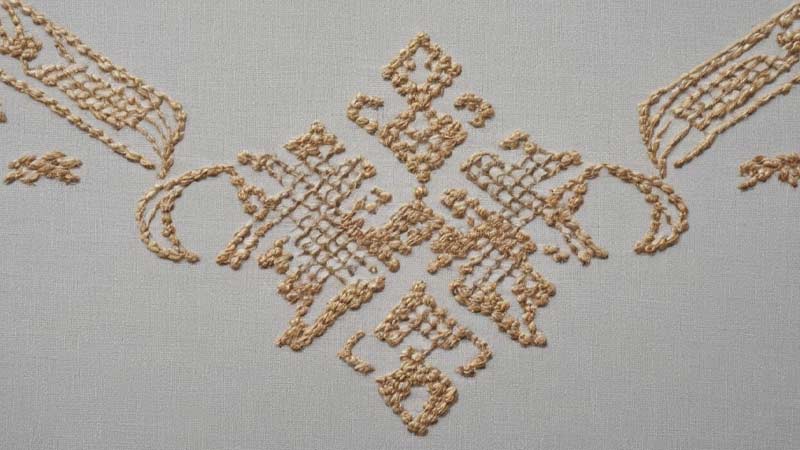
- Overview: Kogin is a type of traditional Japanese embroidery originating from the Tsugaru region in Aomori Prefecture.
- Characteristics: Kogin is characterized by its geometric patterns created through repetitive stitching. Initially used for reinforcing and decorating garments, it has developed into a distinct style with its own set of patterns. Kogin often features straight stitches arranged in a grid, creating visually striking designs.
Hishizashi Embroidery
- Overview: Hishizashi is a type of counted-thread embroidery that originated in Japan.
- Characteristics: Hishizashi involves stitching along a counted thread grid to create geometric patterns. This technique often features intricate designs and is commonly used in making traditional Japanese garments like kimonos and obis.
Goldwork Embroidery (Kinran)
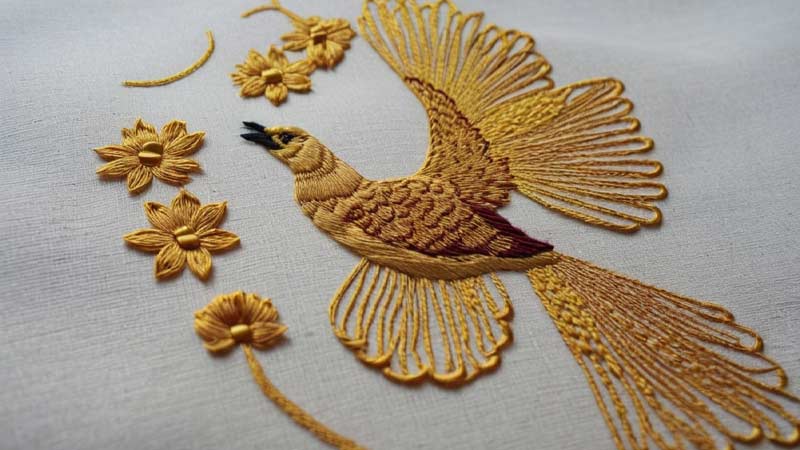
- Overview: Kinran, or goldwork embroidery, involves using metallic threads, including gold and silver, to create intricate and luxurious designs.
- Characteristics: Kinran is often associated with formal and ceremonial garments. It includes the use of couched threads, laid threads, and various other techniques to create opulent patterns. This type of embroidery is seen in imperial regalia and other high-status garments.
Bunka Shishu (Japanese Punch Embroidery)
- Overview: Bunka shishu, also known as Japanese punch embroidery, is a modern form of embroidery that originated in Japan.
- Characteristics: Bunka Shishu uses a specialized punch needle to create textured designs on fabric. Bold, colorful patterns characterize it and are often used for decorative items like wall hangings, cushions, and clothing.
Temari Balls
- Overview: Temari is a traditional Japanese craft that involves embroidering intricate geometric patterns on thread-wrapped balls.
- Characteristics: Temari balls feature vibrant and complex designs created through meticulous stitching. Originally a children’s toy, Temari has evolved into a respected art form with a wide range of intricate patterns and color combinations.
FAQs
What is Japanese embroidery art?
Japanese embroidery art, also known as “Nihon Shishu” or “Nuido,” is a traditional craft that involves the intricate stitching of various motifs on fabric.
What is Japanese Embroidery called in Japan?
In Japan, Japanese embroidery is referred to as “Nuido,” which is a comprehensive term covering various styles and techniques of embroidery.
To Recap
Nuido Japanese embroidery is a testament to Japan’s timeless artistry and cultural richness.
Rooted in tradition, Nuido encompasses a spectrum of techniques and styles, from the refined Nihon Shishu to the contemporary expressions of embroidery.
Characterized by meticulous attention to detail, symbolic motifs, and a harmonious blend of colors, Nuido reflects the deep connection between craftsmanship and cultural heritage.
Through intricate stitches and diverse patterns, practitioners of Nuido create not just textile art but tangible expressions of Japan’s artistic traditions.
This enduring craft bridges the past and present, inviting enthusiasts to immerse themselves in a world where every stitch weaves a story of tradition, creativity, and beauty.
Leave a Reply